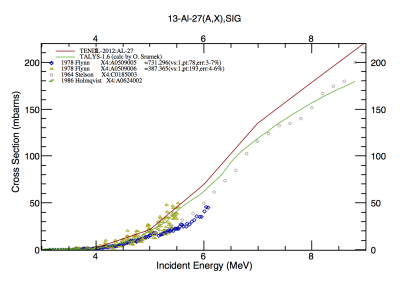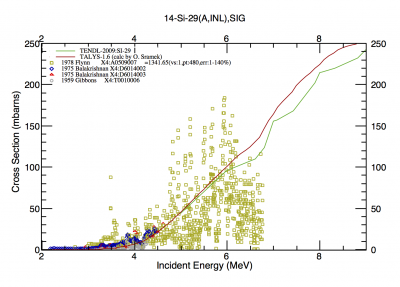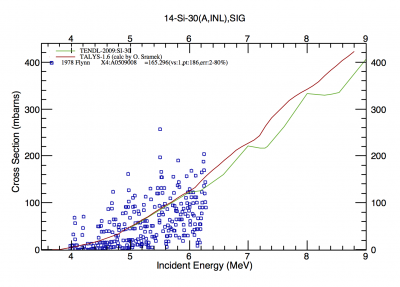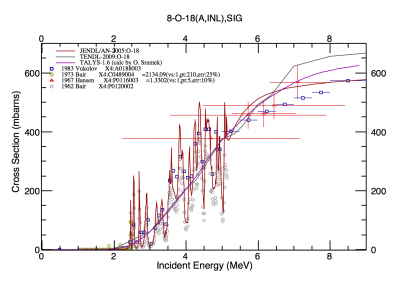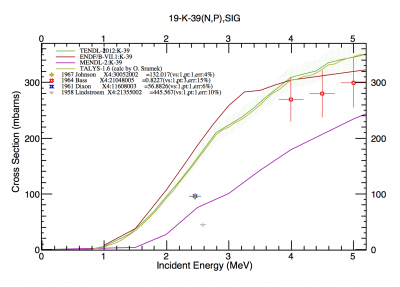Calculation details
This information relates to the following paper: O. Šrámek, L. Stevens, W. F. McDonough, S. Mukhopadhyay, and R.J. Peterson: “Subterranean production of neutrons, 39Ar and 21Ne: Rates and uncertainties.” Geochim. Cosmochim. Acta 196, 370–387, 2017, doi:10.1016/j.gca.2016.09.040 (PDF, BibTeX, arXiv:1509.07436).
Tool to evaluate production rates
We provide a Python script to evaluate the production rates of neutrons and 39Ar from recalculated coefficients. Production rate of 21Ne by (α,n) is equal to neutron production rate with 18O target nuclide. Please see section 5.2 of the paper for details.
Download file evalProdRates.py.zip and after unzipping, follow the instructions reproduced below. Assumes you have Python 3 installed which can be invoked in unix shell as python3.
NAME
evalProdRates
FUNCTIONS
evalRate()
Evaluates nucleogenic production rates of neutrons and of argon-39.
Modify line
wtfrac =
to select compositional estimate.
Optionally modify values in
wtfrac_usr =
if using your own compositional estimate.
Show this help in unix shell: pydoc ./evalProdRates.py
Run in unix shell: python3 evalProdRates.py
Outputs on screen.
Redirect output to file: python3 evalProdRates.py > outfile
Decay chains and α production
We provide decay network schemes as SVG files, and alpha energies and intensities as ASCII text files. Only alpha particles with emission intensities larger than 10-4, after branching is accounted for, are included.
Thorium-232 decay chain: decay network and alpha energies and intensities
Uranium-235 decay chain: decay network and alpha energies and intensities
Uranium-238 decay chain: decay network and alpha energies and intensities
SRIM
SRIM, which stands for Stopping and Range of Ions in Matter, is a software developed by J. F. Ziegler, freely available at srim.org. We use SRIM to calculate the mass stopping power of α particles in natural rock of a given composition.
TALYS
TALYS is a nuclear reaction software developed by A. Koning S. Hilaire, and S. Goriely. It is freely available at www.talys.eu and well documented. We use TALYS to calculate neutron production cross sections and spectra of (α,n) reactions. Here is an example of TALYS input file we use; this one instructs TALYS to calculate α + 18O interaction.
MCNP
MCNP6 is a general-purpose Monte Carlo N-Particle code developed at Los Alamos National Laboratory (mcnp.lanl.gov) that we use to calculate the (n,p) and (n,α) reaction yields. Here is an example of MCNP6 input file we use.
argon39
argon39 is a code I wrote to perform the overall calculation. It calculates neutron production functions, neutron yields, neutron spectra, generates input files for TALYS and MCNP, extracts data from their output files. argon39 is available at github.com/UncleDrO/argon39.
Estimate of cross section uncertainty
(α,n)
In the calculation, we use (α,n) cross sections calculated by TALYS-1.6. We compare these calculated cross sections with experimental data available via the EXFOR database at www-nds.iaea.org/exfor. We integrate each cross section over energy up to 6 MeV (mean α energy in 232Th chain) and calculate the relative difference between the integrated data sets. We use this difference as a measure of the cross section uncertainty.
27Al(α,n)30P→30Si: The relative difference between the integral of TALYS-calculated cross section and of 1978,D.S.Flynn+(A0509005) experimental data is 36 %.
23Na(α,n)26Al→26Mg: The relative difference between the integral of TALYS-calculated cross section and of 1982,E.B.Norman+(C0731004) experimental data is 7.7 %.
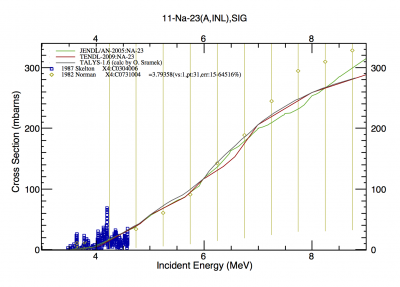
23Na(α,n) cross section. The seemingly infinite error bars in 1982 Norman dataset should in fact be 10% error bars at each point (glitch in EXFOX plotting).
29Si(α,n)32S: The relative difference between the integral of TALYS-calculated cross section and of 1978,D.S.Flynn+(A0509007) experimental data is 7.3 %.
30Si(α,n)33S: The relative difference between the integral of TALYS-calculated cross section and of 1978,D.S.Flynn+(A0509008) experimental data is 20 %.
18O(α,n)21Ne: The relative difference between the integral of TALYS-calculated cross section and of combined 1962,J.K.Bair+(P0120002) and 1967,L.F.Hansen+(P0116003) experimental data is 17 %.
(n,p)
We estimate the uncertainty in similar way as in the case of (α,n) cross sections. Here we integrate up to 3 MeV, above which the neutron energy spectrum is negligible. We compare the ENDF/B-VII dataset (used by MCNP6) to a dataset constructed from 1967,P.B.Johnson+ and 1964,R.Bass+ experimental data points with an added [1 Mev, 0 mbarn] data point. The relative difference of the integrated datasets is 28%.
